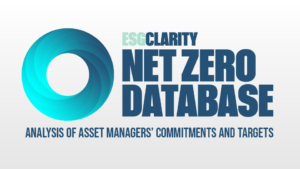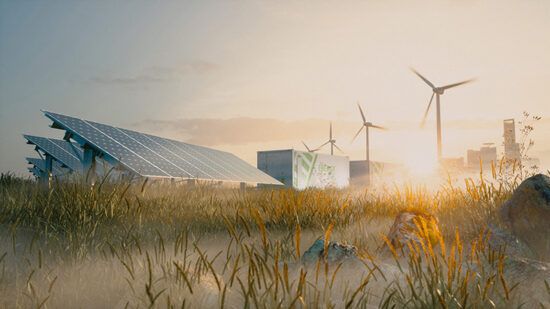In the final part of this Green Dream video interview, Natalie Kenway, editor in chief at MA Financial, speaks to Alex Monk, portfolio manager in the global energy transition team at Schroders, about achieving 1.5 degrees goal, the challenging market conditions and portfolio metrics.
Watch the full video interview above and read the transcript below.
Part 1 of the video can be viewed here.
NK: Hello and welcome back to part two of this Green Dream. I’m speaking to Alex Monk, portfolio manager within the global energy transition team at Schroders. Thanks for joining us again. In part one of the video, you talked about autos being perhaps one of the slower parts of the sector to participate in the transition.
Which areas are you seeing real accelerated growth?
AM: I guess the first thing to say on autos is that while it’s taking a bit of time to transition, and a lot of these companies have had supply chain issues as well, still 30% of all cars sold in Europe last year were electric and 30% of all cars sold in China last year were electric as well.
So the uptake that we’re seeing from electric vehicles has been dramatic. Now, it’s still only 1-2% of the overall fleet, which is what fundamentally matters from an emissions perspective, but actually what you’re seeing in terms of the roll-out of electric vehicles from all the different car companies, both kind of traditional and some of the newer incumbents, and the speed of uptake and interest in uptake from the consumer has been been super, super exciting.
I think some of the other areas that we’re seeing growth, and to some extent, picking individual areas here is is silly in some ways because we’re seeing growth everywhere, but we’re seeing huge demand for hydrogen. Industry demand for hydrogen is really accelerating. It’s easy to look at some of the share price performance in in some of these hydrogen names recently and think, ‘oh my goodness, this industry is slowing down’ but actually, when you look under the surface, so much is happening and not just in the production of hydrogen, but also thinking about how we use hydrogen. One of the reasons we’ve never really used hydrogen in our economy at the moment is that it’s very difficult to use as a molecule. But what we’re seeing now is increased interest in creating e-fuel, so e-ammonia, e-methanol that you can drop in a sustainable aviation fuel or a sustainable shipping fuel.
There’s huge amounts of exciting opportunities and interesting things going on there. Batteries and energy storage are exactly the same. We’re seeing double annualised 100% plus growth in some of these areas. The world is going to need a lot more batteries as we start to use more wind and solar, which is obviously variable. So we’re seeing huge take in interest there and development from a technology perspective as well.
And that’s really what’s exciting for us. When we look across this whole space, we see these S-curve type growths and we’re only at the beginning of these S-curves – we haven’t really reached the acceleration period, and it’s being driven by these fundamental forces of costs, consumer demand and policy support and all these things are still very much aligned and fundamentally driving interest in the adoption of all these technologies.
NK: Okay, fantastic. Let’s talk a bit about the portfolio. How do you measure the portfolios carbon footprint, is that something that you look at and what are you trying to achieve?
AM: The core sustainability objective of the portfolio, particularly with the companies that we’re holding, which again are really providing those technologies and services to drive change, is more to identify those companies that again producing the key products that will help other aspects of the economy reduce their emissions. So to some extent our carbon footprint isn’t relatively high – again, we have zero fossil fuels. We have a low footprint, but we do measure the climate aspects of the portfolio in various different ways. So we do use standardised carbon printing. It has its flaws, but it is a useful measure of understanding how much carbon is within the portfolio. We look at avoided emissions too. Now avoided emissions I guess is a little bit of a a complex kind of metric in that the methodology can vary and it’s a little bit harder to measure in that you’re not removing an emission from the system, if that makes sense.
But it’s quite a useful measure to understand the carbon impact of different technologies across the value chain, which again, from a portfolio like ours is really, really important. We look at climate value at risk as well, or carbon value at risk, and various metrics around that which would essentially look at what happens to company earnings if carbon prices went to a particular level or sort of under various climate scenarios.
So constantly thinking about how resilient the portfolio is from a climate perspective and a carbon perspective is really important. Again, just because we’re an energy transition fund doesn’t mean we have to ignore some of those aspects around carbon and climate that can impact investment returns.
NK: What would you say your outlook is for the energy transition? The IPCC of talking lots about surpassing one and a half degrees. What we can be doing to avoid that?
AM: I think one of the exciting things for us about this space is that over the next 20-30 years a huge amount of new investment needs to come into this space. I think last year in 2022, we surpassed $1trn of investment into energy transition activities. That realistically needs to be running at a rate of $3-4 trillion per year if we’re going to reach net zero and
Now we’ve always said that, okay, maybe we don’t necessarily hit 1.5 degrees, but the direction of travel, even if you only get halfway, – $100trn total is needed if you add up all those numbers that needs to be spent over the next 30 years – so even if it’s only $50trn, that’s an enormous amount of new investment that’s going to be going to the companies in this space for them to deploy and generate new earnings and investment opportunities from.
We’re generally still very, very optimistic about the direction of travel here. Again, hopefully we get to 1.5 degrees. Hopefully we get even lower than that. But even if we don’t, the direction of travel is fundamentally what matters. And again, with everything we’re seeing, there’s so much exciting stuff going on under the surface and it takes time to implement all this stuff.
You know, we can’t just turn our energy transition on with a flick of a light switch. It takes time for companies to deploy the capital, but we are getting there. There is progress being done and that’s certainly what is super, super exciting.
NK: Okay, great. And we’re in some challenging market conditions at the moment. How do you expect companies in your portfolio to perform in this environment?
AM: Yeah, it’s obviously been a difficult period for the investment landscape as a whole. And really we’ve highlighted three key headwinds that have been impacting certainly the energy transition space, but I think the broader market. So, first up, you had the supply chain issues as we reopened from Covid. If you imagine making a wind turbine and shipping it around the world, it’s difficult at the best of times, and it became really, really hard particularly during all the supply chain bottlenecks, higher cost of shipping, high cost of materials. So that’s certainly been impacting the earnings piece – it’s getting a little bit better and we’re starting to see supply chains free up, but it’s still there. We’ve obviously had the financial tightening, which has been putting pressure on valuations and that’s obviously had an impact too.
And now I guess we’re starting to maybe also see the consequences of that in terms of access to capital, access to financing and also a potential slowing of underlying growth. So there are headwinds and we do think in the short term that things will remain volatile. And this can be at times a volatile space just given the profile of the companies, but what gives us excitement is, again, when you look under the surface, the underlying earnings growth for all these companies and the trajectory of earnings growth, as we see more and more demand for electric vehicles, more and more demand for hydrogen and renewables and battery storage and sustainable aviation fuel, it’s still just going from strength to strength, driven by those structural forces of cheap costs versus the alternatives, growing consumer demand and also policy support that we’re seeing in terms of the Inflation Reduction Act in the US, and some of the recent sort of EU announcement.
So it might still be volatile near-term. And again, this sector traditionally has been a little bit more volatile, but looking through that as long-term investors we’re still only at the start of a 10, 20, 30, 40-year shift in our energy system and that structural growth is still coming through, driven by those structural forces.
That gives us excitement on a mid- to long-term view that things are interesting. And I think the final thing to say is that valuations after the last two years have reset a little bit across this space. We obviously saw in the end of 2020 a sort of bubbly period for the sort of the sort of renewable space in particular. Valuations now are almost back to where they were on sort of forward looking views to 2019 levels. So again, we are getting to a point where the fundamentals are still strong. Valuations have reset. It might still be volatile in the near term, but actually on a mid to long term view, we’re probably as excited as we’ve ever been about the broader energy transition opportunity.
NK: Thank you for sharing all of your insights with us. Something light-hearted to finish on, could you share a sustainable activity that you do to lower your own personal carbon footprint?
AM: I think it’s important that ultimately to reach net zero, we all do our own little bit. And obviously the more you can do, the better. But I think even if everybody takes baby steps, it all contributes and adds up. For me, it’s cycling. So I cycle everywhere all the time to work, from work, rain or shine, which can be miserable at times, and you can end up sort of being been very, very wet. Much better on the way home than on the way into the office. But I do little things like that – the more cycling we can do, the more recycling we can do, the healthier we can eat and think about our diets, all of these things add up and help.
NK: Great. Well, thank you so much for coming in today.
AM: It was my pleasure. Thank you.








